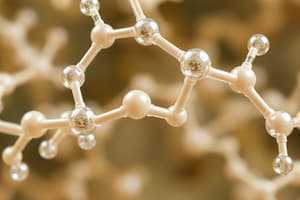Podcast
Questions and Answers
What is the process called when bonds in a polymer are broken by adding water?
What is the process called when bonds in a polymer are broken by adding water?
- Hydrolysis (correct)
- Condensation
- Polymerization
- Dehydration synthesis
Which process involves the formation of a bond between two monomers while losing a water molecule?
Which process involves the formation of a bond between two monomers while losing a water molecule?
- Oxidation
- Hydration
- Dehydration synthesis (correct)
- Dissociation
Which type of biomolecules facilitate the processes of hydrolysis and dehydration synthesis?
Which type of biomolecules facilitate the processes of hydrolysis and dehydration synthesis?
- Carbohydrates
- Nucleic acids
- Enzymes (correct)
- Lipids
What is the meaning of the term 'dehydration synthesis'?
What is the meaning of the term 'dehydration synthesis'?
Which of the following is NOT a type of biological macromolecule?
Which of the following is NOT a type of biological macromolecule?
What is the primary function of nucleic acids in cells?
What is the primary function of nucleic acids in cells?
Which of the following is NOT a characteristic of denatured proteins?
Which of the following is NOT a characteristic of denatured proteins?
What is the role of ATP in cellular metabolism?
What is the role of ATP in cellular metabolism?
Which of the following is a correct statement about the structure of proteins?
Which of the following is a correct statement about the structure of proteins?
What is the primary role of lipids in biological systems?
What is the primary role of lipids in biological systems?
Which of the following is a characteristic of the process of dehydration synthesis?
Which of the following is a characteristic of the process of dehydration synthesis?
What is the primary function of carbohydrates in biological systems?
What is the primary function of carbohydrates in biological systems?
Which of the following is a characteristic of the process of hydrolysis?
Which of the following is a characteristic of the process of hydrolysis?
What is the primary role of RNA in biological systems?
What is the primary role of RNA in biological systems?
Which of the following is a type of biological macromolecule?
Which of the following is a type of biological macromolecule?
Flashcards are hidden until you start studying
Study Notes
Biological Macromolecules
- Hydrolysis: breaks bonds in a polymer by adding water
- Dehydration Synthesis: bond forms between 2 monomers, and a water molecule is lost, facilitated by enzymes
- Dehydration Synthesis: "to put together while losing water", includes cholesterol, female and male sex hormones
Lipids
- Glycerol backbone with 3 fatty acid tails
- Dehydration Synthesis of Fats: 1 glycerol and 3 fatty acids attached by dehydration synthesis, forming triglycerides
- 3 water molecules are formed during dehydration synthesis
- Saturated Fats: contain no double bonds between carbons, solid at room temperature (e.g. butter, lard, shortening, bacon)
- Unsaturated Fats: have double bonds between carbons, liquid at room temperature (e.g. oils)
Proteins
- Made of carbon, hydrogen, oxygen, nitrogen, and sometimes sulfur
- Composed of amino acids
- Functions: building blocks of living materials, compose structural parts, and enzymes
- Found in: meat, eggs, and cheese
- Structure: much larger and more complex than carbohydrates and lipids, containing carbon, hydrogen, oxygen, and nitrogen
Carbon Compounds
- 95% of all carbon compounds are organic
- Carbon atoms can form chemical bonds with other carbon atoms in long chains or rings
- Carbon compounds in living things: carbohydrates, lipids, nucleic acids, and proteins (macromolecules)
Polymers and Monomers
- Polymers: many individual small molecules (monomers) combining to form a larger molecule
- Monomers: individual small molecules that combine to form a polymer
- Examples:
- Carbohydrates: polysaccharides, monosaccharides (simple sugars)
- Lipids: fats, glycerol and fatty acids
- Proteins: amino acids
- Nucleic Acids: nucleotides
Dehydration Synthesis and Hydrolysis
- Dehydration Synthesis: process of joining monomers to form polymers, releasing water molecules
- Hydrolysis: chemical breakdown of polymers into monomers through the addition of water, opposite of dehydration synthesis
Carbohydrates
- Energy-rich compounds made from carbon, hydrogen, and oxygen
- Cells use carbohydrates to get and store energy
- Also called sugars or starches
- Plant cells store energy as starch
Proteins and Amino Acids
- Amino acids: building blocks of proteins, joined by peptide bonds (dehydration synthesis)
- 20 different amino acids, each with a unique R group
- Peptide bonds hold amino acids together, forming dipeptides, tripeptides, and polypeptides
- Denaturation: proteins lose their shape and function when exposed to extreme changes in pH, temperature, etc.
Nucleic Acids
- Compounds made of long, repeating chains called nucleotides
- DNA: a nucleic acid that contains the information cells need to make all of their proteins
- Function: important for growth and reproduction of cells, contains the genetic code
- Structure: sugar (deoxyribose or ribose), phosphate, nitrogen bases
- Building blocks: nucleotides
Studying That Suits You
Use AI to generate personalized quizzes and flashcards to suit your learning preferences.




